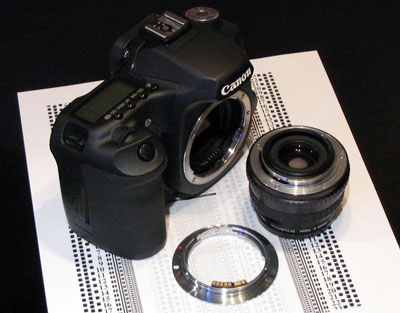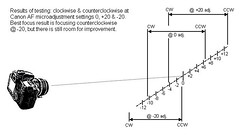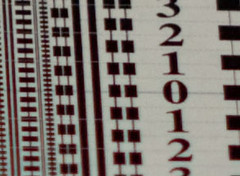
There are plenty of how-tos and articles written about doing autofocus microadjustment for autofocus lenses, but there is not much out there for manual focus glass, which is why I wrote this article.
I had previously programmed the converter to register on the camera as 50mm at f2.0. Unfortunately, the autofocus indicator beep was terribly inaccurate and would produce very out of focus photos. One might think that it would be the same procedure as setting the autofocus microadjustment for an autofocus lens, but this is not entirely true. An autofocus lens will stop in the same plane each time as indicated by the autofocus system. But with a manually focused lens, the autofocus indicator beep will occur at a slightly different plane depending on whether you turn the focus ring clockwise or counterclockwise. This would indicate a slight variation in the focus region, likely taking into account the circle of confusion, but also the degree to which the autofocus system and optics are accurate.
A clear example of this is in the following images. The image on the left is where the focal plane lies with the unadjusted lens turned clockwise, while the image on the right is taken with the lens turned counterclockwise. Even when a number of shots have been taken (all at the same distance of course) and averaged, the results are still the same.

For this autofocus adjustment, I needed a good test chart, so I used Jeffrey Friedl's Autofocus Test Chart. I recommend you first read his site to get familiar with the chart and the testing method before you continue here. Remember, his site deals with autofocus lenses while I will be showing you how to do it with a manual focus lens.
I could have used the Tago adapter to fix the autofocus, as it has 17 levels of adjustments, while the 50D has 40 levels of adjustments. However, I find that the method of "programming" the adapter to be much more troublesome than just using the 50D's menu system.
With an aperture of f2.0, I decided to put the subject at 3 feet from the camera sensor. Using the DOFMaster Depth of Field Calculator, I determined that there should be a 0.95 inch depth of field with these settings, which would be good for testing. The 50D's autofocus microadjustment was set to default 0.
I set the target at approximately 40 degrees off tilt (it doesn't matter how much tilt you use, but the farther you tilt it, the more accurate the readings). Knowing that in my case there would be a bit of a margin of error, I felt 40 degrees was sufficient. I then proceeded to turn the focus ring clockwise until I heard the autofocus confirmation beep (I'll call it the "beep" from now on), then took the shot. I unfocused counterclockwise, slowly focused clockwise again until the beep, then took the shot. I took 5 test shots clockwise and 5 shots counterclockwise using the same method.
I then took an average of the 5 shots, then changed the autofocus microadjustment on the 50D to +20, and repeated the test. Finally, I did the same at -20. Now here's the rub: because you are manually turning the focus dial and getting a beep, you may not always remember if you turned the dial clockwise (CW) or counterclockwise (CCW), or if you turned it slightly between the two ranges. Thus, unlike an autofocus lens, even though you got the beep, the actual subject may not be in focus, so you have to choose how you will focus this lens everytime (clockwise or CCW). This is shown in the following graph where the max & min values from the average of the 3 rounds of test shots were taken at the 3 different microadjustment values (0, +20 and -20).

The best results thus far is turning the focus ring counterclockwise until I get the beep at an AF microadjustment of -20, but there is still room for improvement. I could have changed it to -19, -18 and so on until I got the result I wanted, but I thought of a faster way.
I graphed the average values on a simple XY graph, where the vertical values represented the AF microadjustment, and the horizontal values represented the best focus spot on the test chart for only the counterclockwise values (since this seemed to be on track to the best focus method). What resulted was 3 values in a straight line. To find the perfect AF microadjustment value, I just drew a line from the 0 on the X axis up to the graphed line, and followed it across to the Y axis, which gave me a value of -17. I set the camera's microadjustment to -17, and *poof*, when whenever I manually focused counterclockwise, the subject was in focus.

Since I won't be using this lens for anything too important, and for subjects that aren't too close, I can get away with the margin of error that you can probably notice in the final image. However for my purposes it is fine. Hopefully I can remember to only focus counterclockwise!
0 comments:
Post a Comment